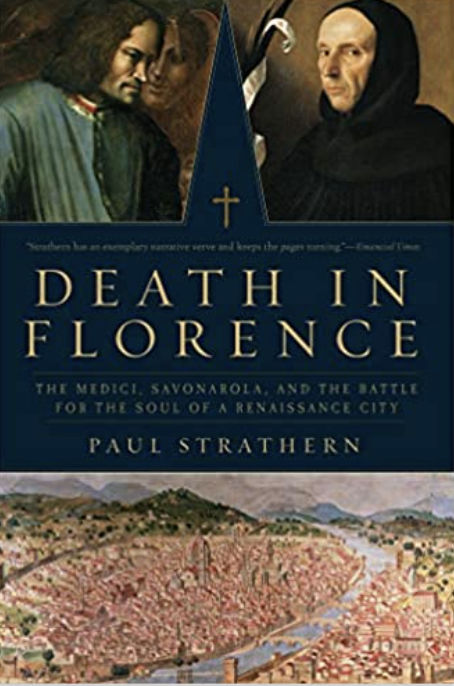|
Death in Florence
By Paul Strathern Published in October 2016 456 Pages Thibault’s Score: 5/5 Death in Florence is the history of one of the most fascinating figures in Florentine history: Girolamo Savonarola. Girolamo Savonarola was a Dominican monk devoted to a life of poverty and piety. He resented the degenerate and decadent life of the Italian Renaissance. Worse, he hated tyranny. When Cosimo de Medici’s idiotic great grandson, Piero the Unfortunate, fails to act at the approach of a French army, Savonarola seizes power. He has Piero exiled, and miraculously manages to turn the French army away through his charisma. As a result of this heroic act, Savonarola discovers that he has the popular mandate. The “small people” flock to his banner, and he becomes the hero of the common man. Savonarola’s short reign over Florence is marked by revolution. During his four year long reign of terror, he embarks on a revolution worthy of Mao or Lenin. He creates real republican reform, giving the suppressed poor people of Florence a voice for the first time. He embarks on radical religious reform, harassing homosexuals, prostitutes, and merchants. He burns all of Florence’s “vanities” (fine art, perfume, luxury goods, etc…). Finally, the book ends with the downfall of Savonarola and his regime. His reign of terror comes to an end; he is excommunicated; betrayed by his supporters; and burnt at the stake/hung (at the same time!). Savonarola’s charisma oozes through the pages of this book. I can really imagine being there. As a sort of modern revolutionary myself (albeit not a reactionary catholic) I can really emphasize with Savonarola’s goals. Savonarola seems completely honest - far more so than Mao or Lenin. He is a truly pious man who only wanted the best for his people. I really like Paul Strathern’s books. His writing style is crisp, and describes scenes well but not excessively. If the worst type of writing is academic writing which gratuitously uses big words; then the second worst type of writing is overly saccharine literary diarrhea; and the best must be the no-bullshit style of Paul Strathern. I strongly recommend this book - and not just for those who want to learn more about the Renaissance. This is a cautionary tale for any would-be dreamers and revolutionaries who want to hear the same old story, but are tired of reading about the Soviet Union. This book masterfully captures the spirit of the day in all of its delightful horror.
0 Comments
Leave a Reply. |
Thibault SerletMost of my articles are book reviews, but I also write about many other topics. Archives
December 2023
Categories |

 RSS Feed
RSS Feed